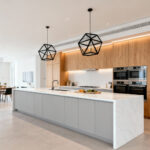Living in a small space often comes with one particularly frustrating challenge: the tiny kitchen. I’ve walked into so many clients’ homes where the kitchen feels less like the heart of the home and more like an afterthought—a cramped, cluttered corridor that makes cooking a chore. But here’s the thing I’ve learned from my background in both psychology and design: the size of your kitchen has almost nothing to do with how you feel in it.
It’s all about perception. Your brain can be gently tricked into seeing openness, calm, and possibility where there was once only confinement. It’s not about magic; it’s about understanding how we interact with our environment on a subconscious level. These aren’t just decorating tips. These are 19 psychologically-driven strategies to transform your small kitchen into a space that not only functions better but feels expansive and, honestly, joyful.
1. Think Up—Draw the Eye to the Heavens
In a small kitchen, we’re programmed to obsess over the limited floor space. We measure every square inch, trying to cram everything in. But what if we’ve been looking in the wrong direction? The single most underused asset in a compact kitchen is its vertical space. Drawing the eye upward is an old-school design trick that works because it creates an illusion of height and airiness, making the entire room feel less compressed.

I once worked with a client in a rental with a laughably small kitchen. We couldn’t change the layout, but we installed simple, tall shelving that went almost to the ceiling. We stored her beautiful (but rarely used) Dutch ovens and a collection of vibrant cookbooks up high. Instantly, the room felt taller and more intentional. Floor-to-ceiling pantry cabinets or even just wall-mounted racks can have the same effect. You’re not just adding storage; you’re changing the room’s entire visual direction.
This shift in focus from horizontal to vertical is fundamental. Once you see that empty wall space as an opportunity instead of a boundary, you start to understand how a few clever moves can completely reframe a room’s emotional impact.
2. Tame the Infamous Corner Cabinet
Kitchen corners. They’re the Bermuda Triangle of cookware, aren’t they? That deep, dark space where Tupperware lids and that one specialty pan you bought on a whim go to die. We all have one, and that wasted, inaccessible space is a constant source of low-grade frustration. But those corners don’t have to be a black hole.

This is where you get smart. Inserts like a Lazy Susan are a classic for a reason, but the real game-changers are the modern blind-corner pull-outs. Systems like a “Magic Corner” or LeMans unit literally swing the hidden shelves out into the open, bringing everything to you. Suddenly, nothing is lost. It’s an almost shocking amount of real estate to reclaim. Frankly, leaving a corner cabinet empty is like paying for a room in your house and never using it.
Transforming these frustrating voids into functional powerhouses does more than just give you more storage. It sends a message to your brain that every part of your space is intentional and under control, which reduces the background anxiety that a chaotic space can create.
3. End the Rummage with pull-out shelves
Stop and think about the physical act of getting a pot from a back of a lower cabinet. You get on your knees, you pull out the three things in front of it, and you blindly fish around in the dark. It’s inefficient and annoying. The psychological cost of that daily “rummage” is decision fatigue and a subtle feeling of dread. The solution is beautifully simple: make the back of the cabinet come to you.

Pull-out shelves and deep drawers completely change how you interact with your belongings. Instead of a dark cavern, your cabinet becomes a layered, accessible system. Everything is visible at a glance. For base cabinets, they’re perfect for heavy pots and pans. For a pantry, they’re brilliant for seeing all your canned goods without having to unstack them. One client told me installing pull-outs in her tiny pantry felt like “getting a new, bigger kitchen” because she could finally use its entire depth.
When you can see everything you own, you use what you have more effectively, buy fewer duplicates, and feel an incredible sense of calm. You’ve eliminated a recurring, frustrating task from your daily life, and that small change has a huge ripple effect.
4. Ditch the Appliance Tyranny
For decades, we’ve been told that a “real” kitchen needs big, beefy appliances. A massive fridge, a 30-inch range, a standard dishwasher. But in a small kitchen, these appliances are space-hoarding bullies. Choosing compact or multi-functional appliances isn’t about compromising; it’s about being smart and demanding technology that fits your life, not the other way around.

Apartment-sized refrigerators (often 24 inches wide), slimline dishwashers (a tidy 18 inches), and smaller ovens give you back precious inches of counter and storage space. And then there are the multi-taskers. A convection microwave that can also bake and broil? It’s a workhorse that saves you from needing three separate machines. We’ve come so far from the days when “small” meant “lesser.” Brands like Fisher & Paykel or Smeg have built their reputations on powerful, beautifully designed appliances for smaller footprints.
It’s about challenging the assumption that bigger is better. An appliance that’s appropriately scaled for your space and needs is the smarter, more efficient, and frankly, more elegant choice.
5. Weaponize Light (Especially Under the Cabinets)
If you do only one thing to make your small kitchen feel bigger, make it this one. Poor lighting makes a space feel like a cave. Shadows in corners and dark voids under cabinets are visual cues that scream “cramped.” A layered lighting plan—ambient (overhead), task (focused), and accent (mood)—is the antidote.

But the secret weapon? Under-cabinet lighting. It’s absolutely non-negotiable in a small kitchen. It does two critical things. First, it brilliantly illuminates your workspace, eliminating the shadow your own body casts from the overhead light. This makes prep work safer and easier. Second—and this is the psychological magic—it makes your upper cabinets appear to float. That little bit of light visually separates the cabinets from the wall, erasing their weight and making the whole room feel lighter and more open.
Connect them to a dimmer switch, and you have the power to transform the entire feel of your kitchen. Bright and energetic for cooking, then soft and atmospheric for a late-night cup of tea. It’s the highest-impact change you can make for the lowest cost.
6. Paint Yourself Some Space
This is where my color psychology brain gets really excited. It’s a proven fact: light colors make a space feel larger. It’s not an old wive’s tale; it’s about physics. Light colors have a higher Light Reflectance Value (LRV), meaning they bounce more light around the room. Dark colors absorb light. In a small kitchen, you want to turn your walls, cabinets, and ceiling into giant reflectors.

This doesn’t mean your kitchen has to be a sterile, all-white box (unless you love that look!). Think of warm off-whites, soft grays, or pale, misty blues and greens. I’m a huge fan of Benjamin Moore’s “White Dove” for a classic warm white, or Farrow & Ball’s “Pale Powder” for a touch of serene color that still feels incredibly airy. Using slightly different shades of the same light color adds depth without creating harsh visual breaks.
The key is to blur the boundaries. When the walls, trim, and even cabinets are in similar light tones, your eye glides over them, unable to immediately register the room’s edges. This creates a perceptual expansion that can make a tiny kitchen feel open and breathable.
7. Choose a Layout That Knows How to Dance
If you’re planning a reno, the layout is everything. In a small space, the goal is to create an efficient “work triangle”—the path between your fridge, sink, and stove. Two layouts are the undisputed champions of the compact kitchen: the Galley and the L-Shape.

A Galley kitchen, with its two parallel walls, is like a highly efficient corridor. Everything is just a step or two away. It’s perfect for one cook because the workflow is tight and uninterrupted. There’s a reason professional kitchens often use this model—it’s pure function. An L-shape layout uses two adjacent walls, tucking the work triangle neatly into a corner. This is brilliant because it keeps foot traffic out of your cooking zone and often opens up the rest of the room for a small table or a bit of breathing space.
What I love about these layouts is that they embrace the constraints of the space rather than fighting them. They prioritize fluid movement and function, which in turn makes the kitchen a more pleasant, less chaotic place to be. They create a natural rhythm, a little dance for the person cooking.
8. Find a Beautiful Balance: Open Shelves vs. Closed Cabinets
A wall of solid upper cabinets can feel like a heavy, looming presence in a small kitchen. It’s a visual wall that stops your eye cold. But going fully open-shelf can be a recipe for visual chaos if you’re not ruthlessly tidy. The most psychologically satisfying solution? A thoughtful mix of both.

Here’s the rule of thumb I give my clients: open shelves are for the things you use daily and the things that are beautiful. Your everyday dishes, a few nice glasses, a small plant, a stack of attractive bowls. These items become part of the decor. Closed cabinets are for the rest—the mismatched mugs, the bulky blender, the half-eaten bag of chips. The stuff of real life. This balance breaks up the visual weight of the cabinetry, allowing your eye to travel further back to the wall, which creates a sense of depth.
It’s a curated approach. You’re consciously choosing what to hide and what to reveal. This balance creates a visual rhythm and makes your kitchen feel intentionally designed and personalized, not just packed with storage.
9. Bring Order to the Chaos Within
You can have the most beautiful kitchen in the world, but if opening a drawer unleashes an avalanche of whisks, spatulas, and mystery gadgets, your brain still registers it as chaos. Organization isn’t just about tidiness; it’s about reducing your cognitive load. Every time you open an organized drawer, your brain gets a tiny, satisfying hit of calm.

Drawer dividers are non-negotiable. Don’t just get one tray for silverware; get adjustable bamboo dividers that section out the entire drawer. Use vertical dividers for things like baking sheets and cutting boards—storing them on their sides is a space-saving revelation. Tiered risers for your spice cabinet let you see everything at once. This isn’t just about cramming more stuff in; it’s about making everything accessible and predictable.
I tell my clients to start with just one drawer. The junk drawer. Spend 15 minutes transforming it. The immediate feeling of relief and control is often all the motivation you need to tackle the rest. An organized kitchen simply feels bigger because there’s no mental or physical friction.
10. Turn Your Walls Into Working Art
When your drawers and counters are full, look to the walls. Blank wall space is a missed opportunity. A pegboard or a set of sleek magnetic strips can turn an empty wall into a hyper-functional, and surprisingly stylish, storage hub.

Julia Child’s kitchen, with its famous pegboard wall, is iconic for a reason. It proves that functional tools, when organized beautifully, can be decor. A pegboard is infinitely customizable for hanging pots, utensils, and even small baskets. Magnetic strips are fantastic for knives—they keep the blades sharp and safely out of a drawer, plus they look incredibly professional. They’re also great for metal spice tins.
What I love about this strategy is that it keeps your most-used tools within easy reach while freeing up precious drawer and counter space. It’s an approach that celebrates the tools of the trade, turning them into a functional art installation.
11. Create Counter Space on Demand
One of the biggest complaints I hear about small kitchens is the lack of prep space. You put the cutting board down, and suddenly there’s nowhere for the bowl of chopped onions to go. But what if you could summon more counter space only when you needed it? That’s the beauty of fold-down or extendable surfaces.

These are genius. A wall-mounted drop-leaf table can be a breakfast nook for one, then fold flat against the wall. A pull-out cutting board integrated directly under the countertop is always there when you need it. Some rolling carts or islands even come with hinged extensions. It’s about creating a kitchen that adapts to the task at hand.
These flexible solutions are perfect for renters or anyone who doesn’t want to commit to a full renovation. They give you the functionality of a larger kitchen without permanently sacrificing the open floor space you need to move around comfortably.
12. Rethink Your Sink (Yes, Really)
The sink area can be a huge space hog. In a small kitchen, a massive double-bowl sink is often a mistake. A single, deep bowl is usually far more practical—it gives you enough room to wash a large pot while taking up less valuable counter real estate. And how it’s installed matters. An undermount sink creates a seamless transition from the counter into the sink, which makes the area look less cluttered and is a dream to wipe clean.

But don’t stop there. The faucet matters, too. A sleek, high-arc, pull-down faucet combines the sprayer and tap into one, eliminating the need for a separate piece of hardware. Better yet, look into a “workstation” sink. These are sinks with a built-in ledge that holds custom accessories like a cutting board or a colander that slides across the top. It effectively turns your sink into another prep zone.
It may seem like a small detail, but when every inch counts, a well-chosen sink and faucet can be a total game-changer for your kitchen’s workflow and visual flow.
13. Use a Little Smoke and Mirrors
Okay, not literally smoke, but definitely mirrors. Or at least, reflective surfaces. This is pure psychological trickery, and it works beautifully. Reflective surfaces bounce light and images around, creating an illusion of depth and space that can be startlingly effective.

A mirrored or glass backsplash is a fantastic choice for a small kitchen. It will capture the light from a window and reflect the room back on itself, visually doubling the space. If a full mirror feels too bold, consider other reflective materials: high-gloss cabinet finishes, polished chrome or brass hardware, a glossy subway tile, or even a shiny stainless steel appliance.
The trick is to be strategic. You want to place these surfaces where they will multiply light and reflect something visually pleasant—not a cluttered countertop. A little bit of shine can make a dark corner disappear and bring a dynamic, light-filled energy to the room.
14. Embrace the Art of Decluttering
In a small kitchen, clutter isn’t just messy—it’s oppressive. It screams at your brain, making the space feel chaotic and even smaller than it is. Your countertops are not storage surfaces. I’m going to say that again. Your countertops are not storage surfaces. A strict decluttering routine is the foundation of a functional and serene small kitchen.

And let’s be clear: decluttering and organizing are two different things. You have to declutter first. Get rid of the expired spices, the duplicate vegetable peelers, the novelty gadget you used once. Be ruthless. Only then can you organize what’s left. A common stumbling block is holding onto things “just in case.” If you haven’t used it in a year, you probably won’t. Give it away and reclaim that space.
I challenge you to try the “one in, one out” rule. If you buy a new coffee mug, an old one has to go. This simple habit prevents the slow, creeping accumulation of stuff. The mental clarity you gain from having a clear, functional space is a bigger reward than any gadget you’re holding onto.
15. Your Kitchen’s New Best Friend: The Mobile Cart
What if you could have an island, but only when you want one? That’s the magic of a small, mobile kitchen cart. For anyone lamenting a lack of counter space or storage, these little workhorses are a revelation. They are flexibility embodied.

You can use a cart as a mobile prep station, a coffee bar, or extra storage for produce. Roll it out when you’re cooking up a storm, and then tuck it neatly against a wall or in a nearby nook when you’re done. Look for one with lockable wheels for stability, a durable top like butcher block or stainless steel, and some handy shelves or drawers below.
I’ve seen clients use them in incredibly creative ways—as a baking center loaded with flour and sugar canisters, or as a bar cart that gets rolled into the living room for parties. It’s an affordable, non-permanent way to add a huge amount of function to a kitchen that’s tight on space.
16. Make Your Appliances Disappear
There’s a subtle but powerful visual trick that can make a small kitchen feel incredibly sleek and spacious: integrated appliances. These are appliances—like your dishwasher or refrigerator—that are fitted with a front panel to match your cabinetry. The result? They disappear.

Instead of your eye being stopped by a big block of stainless steel here and a patch of white enamel there, it sees a continuous, seamless wall of cabinetry. This visual continuity is calming and makes the entire space feel more cohesive and expansive. It’s a high-end look, but it has a profound psychological effect. When you can’t tell where the cabinets end and the appliances begin, the kitchen just feels bigger.
If a full suite of integrated appliances isn’t in the budget, you can get a similar, albeit less dramatic, effect by choosing slimline models that are simply less bulky and obtrusive than their standard-sized counterparts. The goal is always to reduce visual interruptions.
17. Use Every Last Vertical Inch
We’ve already talked about drawing the eye up, but let’s take it a step further. I mean literally using the full height of the room, right up to the ceiling. That foot of space above your standard upper cabinets? That’s prime real estate. Same for the awkward gap above the fridge or a doorway.

Floor-to-ceiling cabinets are the ultimate solution for maximizing storage volume, creating a clean, seamless look. But even without a renovation, you can add shelving or attractive baskets above your existing cabinets. This is the perfect spot to store seasonal items, specialty serving dishes, or anything you don’t need every day. You’ll likely need a small step-stool, but that’s a small price to pay for reclaiming so much usable space.
By using the entire volume of the room, you free up your lower, more accessible cabinets for everyday items. It forces a more logical organization system and, by making the room appear taller, contributes to that all-important feeling of spaciousness.
18. Find Serenity in a Minimalist Approach
Minimalism gets a bad rap. People think it means cold, sterile, and empty. But that’s not it at all. True minimalism isn’t about having nothing; it’s about making sure that everything you have is either beautiful or useful (and preferably both). In a small kitchen, this mindset is transformative.

A minimalist aesthetic means clear countertops, clean lines, and a “less is more” approach to everything from gadgets to decor. It’s about fighting visual clutter at every turn. Why? Because research in neuroscience shows that a cluttered environment overloads our visual cortex, creating stress and making it hard to focus. A visually simple space, on the other hand, is calming. It allows your mind to rest.
If you struggle with this, start small. Clear off everything from your countertops except for 3-5 essential or beautiful items (say, your coffee maker, a knife block, and a small plant). Live with it for a week. The feeling of calm and order that it brings is often all the proof you need that in a small kitchen, visual peace equals perceived space.
19. Let Your Kitchen Breathe
This last one is about the invisible environment. A small kitchen concentrates everything: heat, steam, and cooking odors. A lingering smell of fried onions or fish from last night can make a small space feel stuffy and oppressive. Excellent ventilation isn’t a luxury; it’s essential for keeping your kitchen feeling fresh and open.

A range hood that actually vents to the outside is vastly superior to a recirculating one (which mostly just moves smelly air around). Turning it on before you start cooking and leaving it on for a few minutes after you finish makes a world of difference. If you have a window, crack it open to create cross-breezes.
This isn’t just about smell. Good ventilation removes airborne grease particles that can create a sticky film on your surfaces over time, and it helps control humidity. A kitchen that feels fresh, clean, and airy will always feel more pleasant and spacious than one that feels stale. It’s an invisible element of design that has a very real, very powerful impact on how you experience the space.
Small Kitchen, Huge Possibilities
A small kitchen isn’t a life sentence to culinary frustration. If you look at it through a psychological lens, you’ll see it has real advantages: an efficient workflow, lower renovation costs, and it forces you to be more intentional about what you own.
By using these strategies—thinking vertically, taming clutter, playing with light and reflection—you can create a space that feels open, functions brilliantly, and truly feels like the heart of your home. It proves, without a doubt, that a kitchen’s greatness isn’t measured in square feet, but in its thoughtfulness and charm.






